If the new, fifth-generation BMW M4 has any chance whatsoever of being remembered as one of the great M cars, then it will need to step up, right from the word go, and face the mighty but no longer cutting-edge Mercedes-Benz C63 AMG.
Because if the new twin-turbocharged M4 can’t level with the big-hearted but now seven-year-old C63 on broadly equal terms, it will surely be classed – in M car terms, at least – as a dud.
We ruin a set of tyres putting the BMW M4 through its paces
But before we delve any deeper into the nitty-gritty of how the £56,635 M4 stacks up beside the £57k C63 – tested here in rather more expensive 507 limited-edition guise, costing more than £67k – what’s the difference between the new M4 and its more familiar-sounding cousin, the latest M3? And what does it bring to the table with which to counteract the raw potency of the C63 AMG?
New BMW M3 vs M4
From the ground up, this F60-model M4 is – just like its mechanically identical four-door brother, the M3 – a brand-new car. New engine, new chassis, new gearbox, new brakes – a new era in the history of the most popular M car, indeed, with a suitably impressive set of on-paper credentials to match.
The headline improvements are myriad and focus mostly around the car’s extensive use of new lightweight materials, including carbonfibre-reinforced plastic, to exact a weight reduction of approximately 80kg compared with the V8 M3. That’s a big step in a good direction, and it means that just about everything else on the car gets a decent head start.
Having said that, BMW has, of course, also improved most other aspects of the car, so the twin-turbo straight six engine produces a small amount more power than the V8 – 425bhp versus 421bhp – and a huge hit of extra torque, which rises from 295lb ft to a thumping 406lb ft, all of which is developed between 1850rpm and 5500rpm. And because there’s less weight to haul around, the leaps in both power-to-weight and torque-to-weight ratios are even more dramatic than you might think.
Watch Autocar's BMW M3 video review
The chassis, steering, brakes and suspension have also been designed and engineered to a level that is well beyond anything previously seen in the M3. The rear subframe is now solidly mounted to the body and is one of the few major components on the car still to be made from steel, while the aluminium front subframe is aided in its quest to create stiffness by a full carbonfibre strut brace.
And although the basic suspension design remains as before, with struts at the front and a multi-link axle at the rear, the attention to detail within that familiar design is unprecedented.
Same goes for the power steering, which is electrically assisted but, according to BMW, has been meticulously engineered to contain the feel and precision of a true M car. There are three different modes that can be selected for the steering and, if you specify the optional Adaptive M suspension, the dampers too.
The responses and weighting of both elements get meatier and more urgent as you scroll up through the three-tier menu (of Comfort, Sport and Sport+), enabling a driver to make his or her M4 feel increasingly sharp, claims BMW.
Dial in the effects of an Active M Differential – which is a standard fitment and can go from completely open to 100 per cent locked – and a set of optional carbon-ceramic brakes (an extra £6k) plus some bespoke Michelin Pilot Super Sport rubber (18-inch as standard, 19-inch option fitted to the test car) and you end up with an M car that, on paper at least, looks very much like the real deal.
And that’s before you so much as mention the M car’s increased ecological awareness. According to BMW, the M4 is at least 25 per cent more economical than its predecessor and puts out a mere 194g/km, despite boasting an incredible 40 per cent more torque than the old V8.
Introducing the competition
So, thus endowed, how does the M4 stack up beside the C63 AMG 507? In theory, the BMW is more than £10k cheaper than the AMG, but with the test BMW’s optional carbon-ceramic brakes discs and dual-clutch gearbox in situ, plus a couple of other choice interior options, their prices soon become much more evenly matched.
True, this leaves the C63 on steel brakes with which to take on the M4. And the AMG weighs over 200kg more than the BMW, too. But the C63 counters with more power (500bhp to 425bhp), more torque and one of the sweetest rear-drive chassis you could ever wish to come across in a car with four seats and a decent-sized boot. So the M4 will need to be more than just capable to live with it, and downright brilliant to better it.
To begin with, though, the BMW appears to be largely unfazed by the C63. Its cabin instantly feels more modern, more focused and slightly better appointed. It also has more room in its rear seats. And, most important of all, it seems to go a fair bit harder than the C63, particularly in the mid-range. And it rides more comfortably. Initially, in fact, the BMW feels like it could take care of the AMG at a canter.
But then the M4 is one of those cars that, apart from one major caveat that we’ll come to in a moment, feels ‘right’ from the moment you climb aboard. Its cabin is refreshingly simple and intuitive for a contemporary M car, its driving position close to perfect apart from the electric driver’s seat’s inability to drop another inch lower. And when you fire it up, the twin-turbo straight six motor emits a potent, deep-chested burble. All the signs, in other words, are flawless.
Watch the Mercedes C63 AMG take on the Audi R8 in Autocar's drift challenge
Engage first gear in the optional M DCT gearbox, squeeze the throttle and move away and, again, the M4 feels correct – like a proper M car should. Its ride is firm but compliant, the steering is meaty and precise, there is masses of support from the bucket-shaped driver’s seat and the response to the throttle is instant, despite the turbocharging.
Torque builds quickly in the M4 and it responds seemingly from little more than idle speed. This is a car, you soon realise, that wants to go. It strains hard against its leash pretty much from the second you start to move, like a powerful dog that hasn’t been fed for a while. And the moment the revs reach anything above 2000rpm, the acceleration starts to really flow.
In the first two gears, there is so much poke low down, in fact, that the torque flow is restricted because, clever as the ESP system may be, it can’t deal with the effects of 406lb ft all on its own. Even so, the light still flickers if you open the throttle with any enthusiasm in first or second gears and the ESP will intervene momentarily. And this is on a bone-dry road, remember.
In third, though, there is no torque restriction, and only then – when the M4 can generate full traction untethered by its electronics – do you get to appreciate how much more rabid it feels than before. And how much more energy it contains within its new engine bay. The mid-range performance it can summon is little short of spectacular, to a point where, back in the UK, it really will feel like a proper licence loser, I suspect.
But there is one fairly major caveat to the M4’s performance. It concerns the way that it delivers its performance, and it’s this: so linear is the flow of torque between 2000rpm and 7000rpm that there is a lack of edge to its delivery. In many ways, it feels like a really potent turbodiesel rather than a high-revving petrol-powered sports coupé, and that’s because there’s almost no sense of crescendo to its power delivery.
Instead, the M4 feels – and sounds – as lively at 2500rpm as it does at 7000rpm, and for a petrol-powered M car, this comes as a fairly major disappointment. The surging, slightly manic sense of excitement that has defined the M3’s personality since 1986, right up until this point in time, is simply no longer there. And it has been replaced by a more efficient, much more clinical but rather less memorable flow of power.
Read Autocar's first drive of the new BMW M3
To some, this won’t matter one iota. But to others, it will mean everything – and to these people, the latest M3/M4’s engine might come across as a touch beige as a result. Quite unlike the C63’s 6.2-litre V8, which actually has less low-down thump than the M4’s turbo but about four times as much zing over the last 2000rpm, plus, of course, a traditional V8 soundtrack to die for.
And once you get the C63 singing in its optimum rev range – between 3000rpm and 6500rpm – it hits every bit as hard as the M4. Harder, in fact, in the epicentre of its power band at around 5000-5500rpm, and the numbers support the subjective impression. The BMW needs only 4.1sec to hit 62mph, the AMG just a tenth more at 4.2sec, so although they couldn’t feel more different from one another in the way that they get there, they arrive at almost exactly the same time. And on the way there, the AMG feels – and sounds – hugely more invigorating.
Having said that, the BMW’s dual-clutch gearbox works more precisely than the AMG’s automatic transmission, delivering faster manual shifts, up or down, even if they are pretty much as good as one another in auto mode. The BMW also rides a fair bit more smoothly on rough roads and generates a touch less tyre noise. But what it doesn’t do is steer as sweetly as the Mercedes, and again it’s the AMG’s extra touchy-feely appeal that keeps it out of reach of the M4.
The BMW’s steering is perfectly okay in its accuracy and precision, but it doesn’t simmer with feel like the AMG’s. You aim the M4 and it goes, with only a variation in weight detectable if you scroll up through its various response modes. In the C63, though, there is something altogether more cerebral about the way that you guide the car through a corner. Your fingertips pick up nuances at the Alcantara rim and fire messages towards your brain that then make your heart beat that little bit faster. And it’s a quite lovely thing to experience.
And in a way, the same thing applies to its handling balance, despite the AMG being a fair bit heavier and feeling it when you start to muscle it about. The M4 has a touch more agility in that it simply generates less inertia when slicing into a bend, and it settles beautifully at the rear, delivering lots of feel from its rear axle when planted in a corner.
But the AMG turns in more keenly and feels pretty damned composed as well near the limit. And both of them are as good as one another when it comes to the highly irrelevant but delightfully indulgent art of going sideways, the BMW’s Active M Differential allowing you to perform just as big a slide as you can in the C63.
A winner is chosen
So where does that leave the M4 beside the mighty C63? Is it a hero or a zero?
Neither, truth be told. The M4 is far too good a car in far too many areas to be presented with any kind of a wooden spoon. But at the same time, it’s a touch too digital in some of its key responses beside the old-fashioned brute of a car that is the AMG to be declared as the new, undisputed king.
In all but a couple of respects, the M4 is a deeply impressive, highly appealing machine that embraces the modern era and shows that monster performance, great handling and major driver appeal can go hand in hand with ecological responsibility and a competitive price – and still with a petrol engine thumping away beneath its bonnet.
But the devil is in the detail in this instance, and when you drill right down into the M4’s personality, shine the light right into its eyes, it doesn’t so much fold as fail to stand up and knock you to the floor. But the C63 does, and that’s the difference. It’s an old-school fighter of a car, and you can’t help but love it that little bit more as a result.
It’s the last of a kind, though, so if you want to remember the way it was, look no further. And in the new M4, well, the future still looks pretty bright to me.
BMW M4 coupé
Price £56,635 0-62mph 4.1sec Top speed 155mph (limited) Economy 34.0mpg CO2 194g/km Kerb weight 1537kg Engine 6 cyls in line, 2979cc, twin-turbo, petrol Power 425bhp at 5500-7300rpm Torque 406lb ft at 1850-5500rpm Gearbox 6-spd manual
Mercedes-Benz C63 AMG 507 coupé
Price £67,270 0-62mph 4.2sec Top speed 174mph Economy 23.5mpg CO2 280g/km Kerb weight 1730kg Engine V8, 6208cc, petrol Power 500bhp at 6800rpm Torque 450lb ft at 5200rpm Gearbox 7-spd automatic

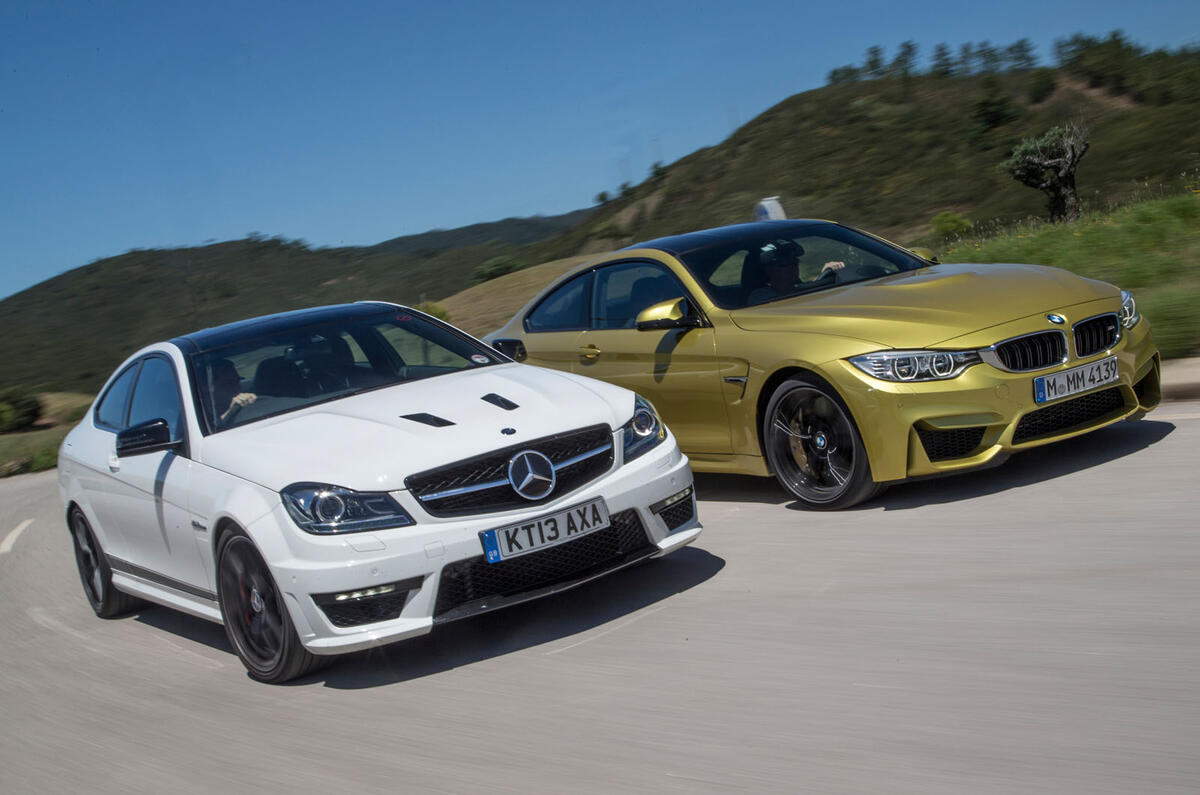




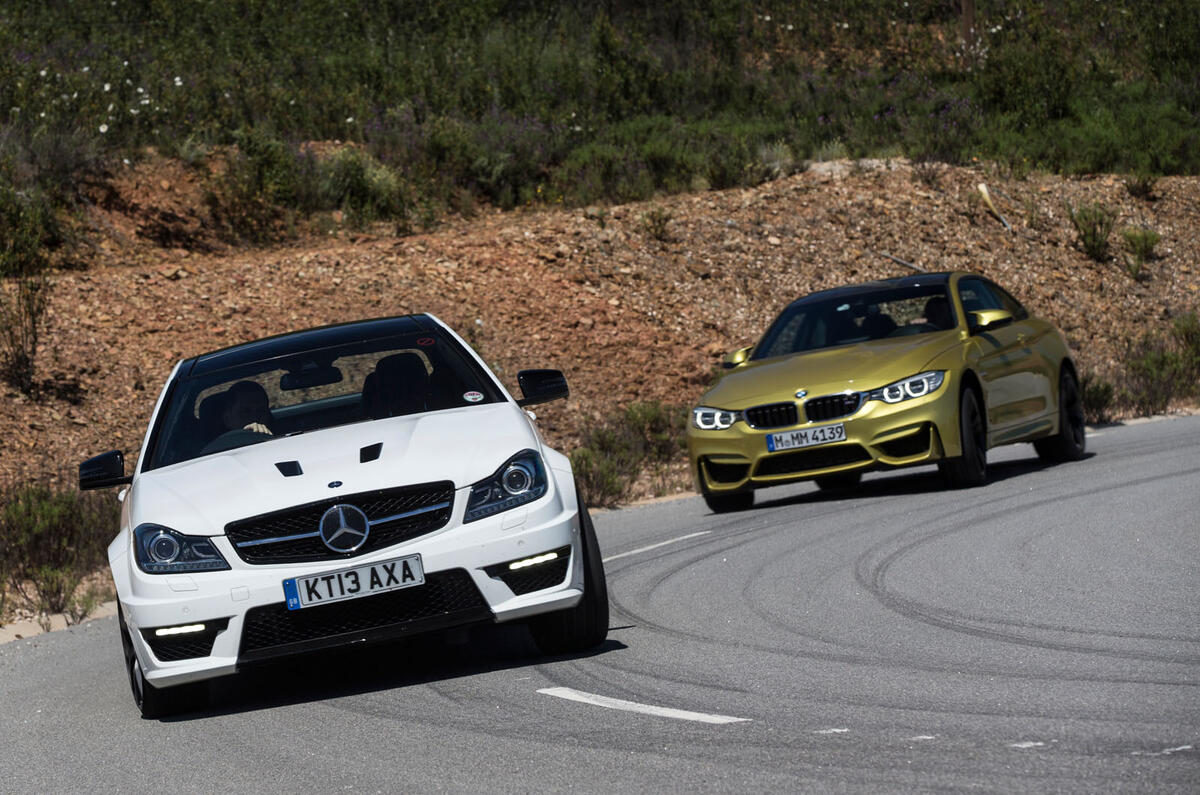















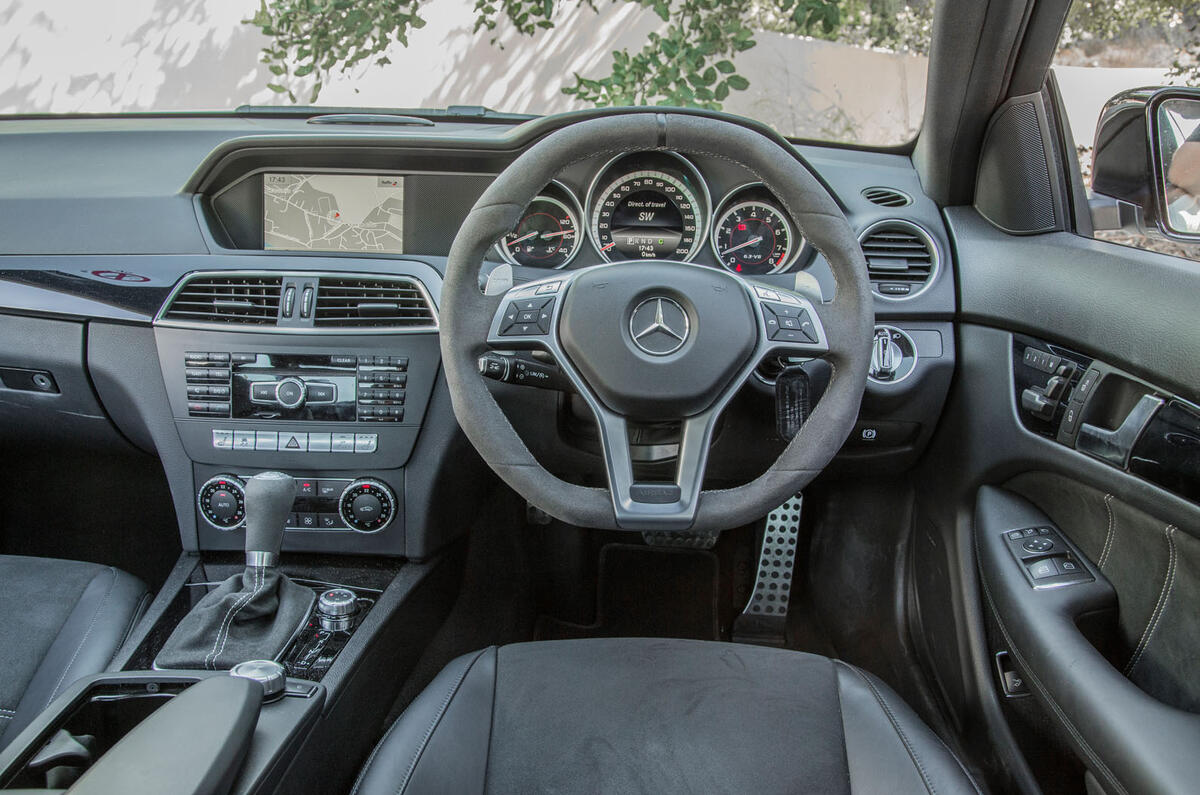
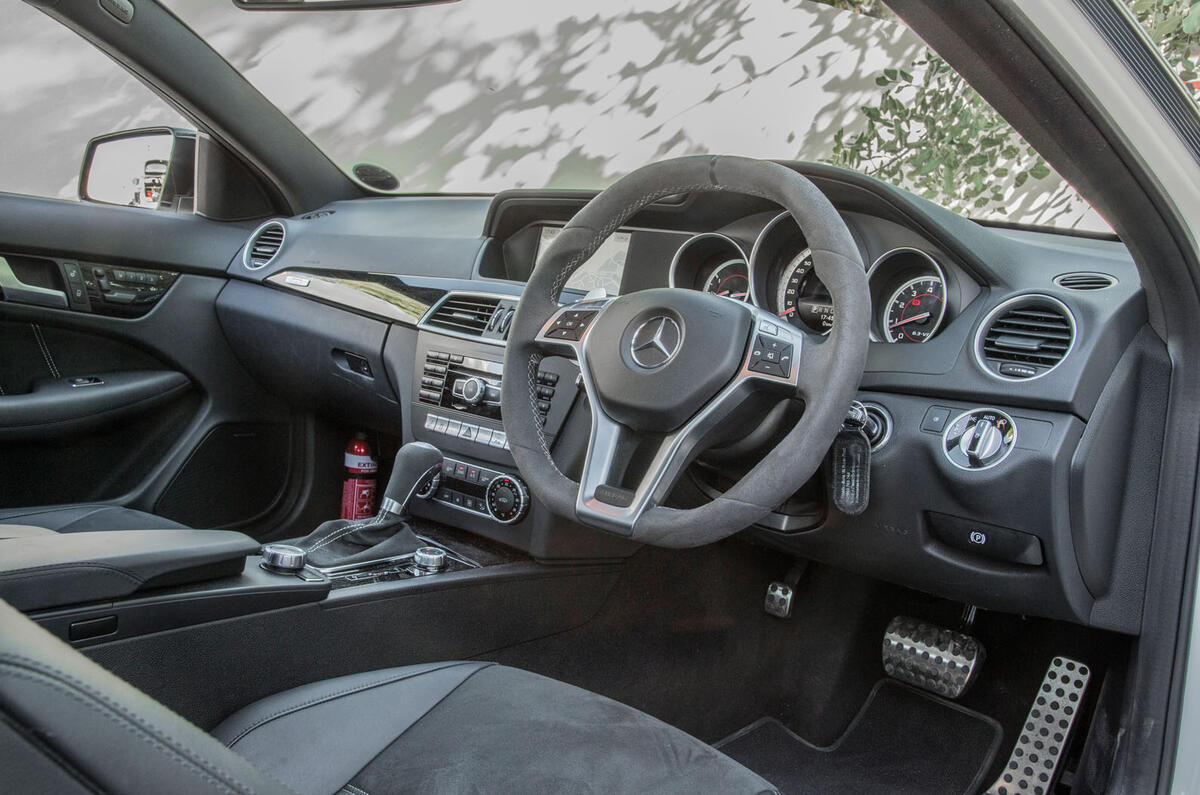












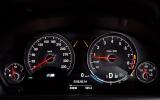






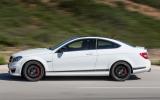






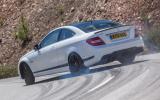


Join the debate
Add your comment
Meanwhile in the real world,
The way things are going
It's good to see that BMW have still managed to produce a compelling drivers car despite this caveat - if you view turbocharging as an issue. I'm sure the next Merc C63 (or however they badge it) will be equally as good, but suffer from this same "flaw".
I have to wonder, though, if this doesn't make for an easier to live with, more everyday car, than one with a screaming NA V8. If I can afford an M3/M4 it would be my only car, and the vast amount of my time in it would be spent pootling around town - precious little would be the type of back-roads blasts that these sort of reviews tend to focus on.
A bit like having a car that can do 150 mph +, you'll never use it the way that the reviewers do (or maybe just occasionally on a track), but it's nice to know that you could if you wanted to.
AMG for me